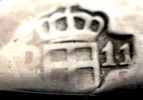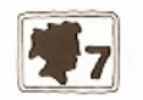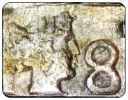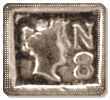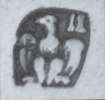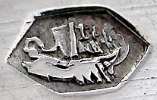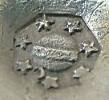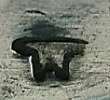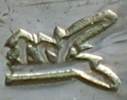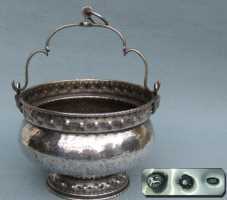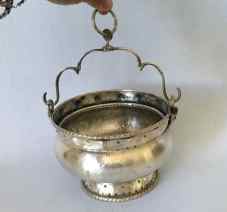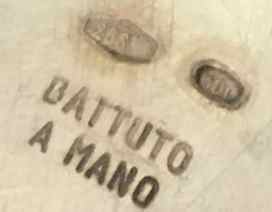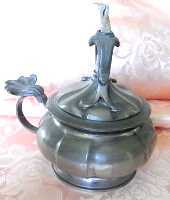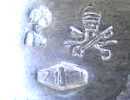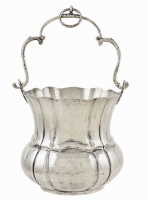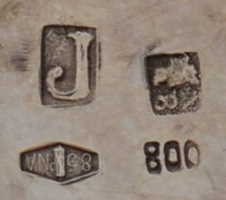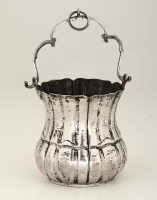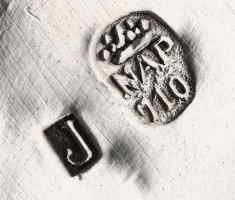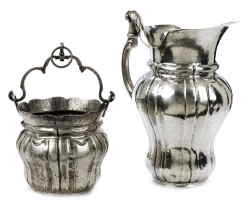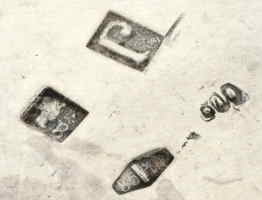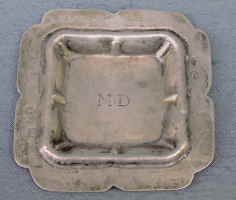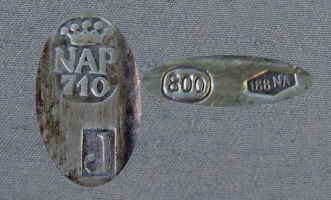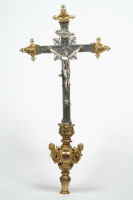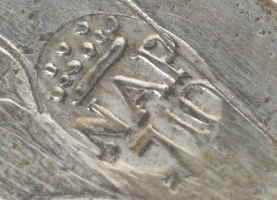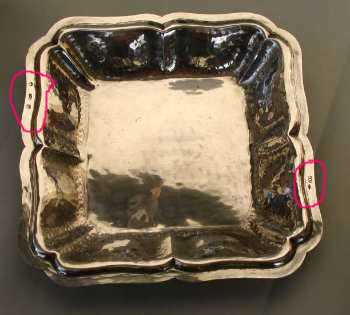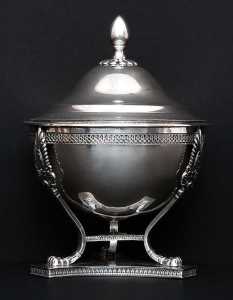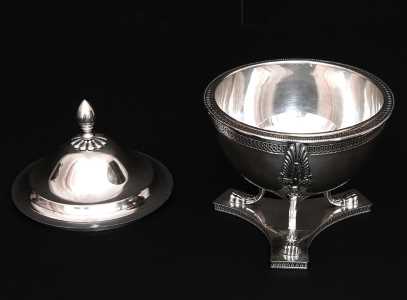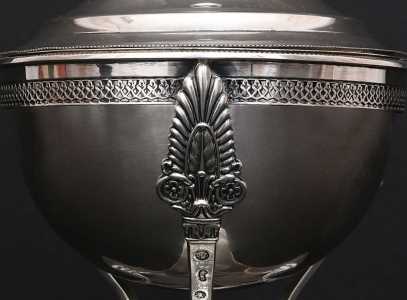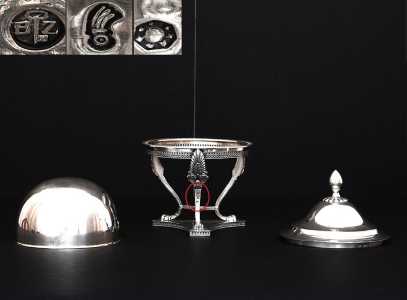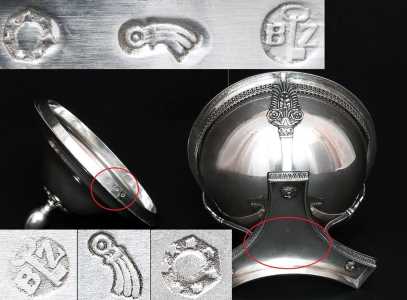FORGERY IN ITALIAN SILVER
Until its unification Italy was divided into various kingdoms, dukedoms (more or less independent) and the State of the Church under the Pope government.
Each one of these territorial entities used a different silver purity level and had its own hallmarking system.
In this page are illustrated the most common pre-unitarian hallmarks. For a wider selection and further details follow the links to the pages of "HALLMARKS OF ITALIAN SILVER"
REGNO DI SARDEGNA (KINGDOM OF SARDINIA, Torino/Turin)
|
(left to right)
Torino hallmark, 916/1000 silver fineness, date 1814/1824
Torino hallmark, 750/1000 silver fineness, date 1814/1824
Torino hallmark, 950/1000 silver fineness, date 1824/1872
Torino hallmark, 800/1000 silver fineness, date 1824/1872
|
STATO PONTIFICIO (PAPAL STATE: Roma/Rome)
(left to right)
Roma hallmark, 889/1000 silver fineness for large works, date 1815/1870
Roma hallmark, 889/1000 silver fineness for small works, date 1815/1870
|
REGNO DELLE DUE SICILIE (Napoli/Naples)
(left to right)
Napoli hallmark, 916/1000 silver fineness, date 1824/1832
Napoli hallmark, 833/1000 silver fineness, date 1824/1832
Napoli hallmark, 916/1000 silver fineness, date 1832/1872
Napoli hallmark, 833/1000 silver fineness, date 1832/1872
|
GRANDUCATO DI TOSCANA (GRAND DUKEDOM OF TUSCANY: Firenze/Florence))
Firenze hallmark, 792/1000 silver fineness, date 1832/1872
|
DUCATO DI MODENA E REGGIO (DUKEDOM OF MODENA AND REGGIO: Modena)
(left to right)
Modena hallmark, 916/1000 silver fineness, date 1818/1872
Modena hallmark, 832/1000 silver fineness, date 1818/1872
|
DUCATO DI PARMA E PIACENZA (DUKEDOM OF PARMA AND PIACENZA: Parma)
(left to right)
Parma hallmark, 917/1000 silver fineness, date 1821/1872
Parma hallmark, 792/1000 silver fineness, date 1821/1872
|
DUCATO DI LUCCA E PIOMBINO (DUKEDOM OF LUCCA AND PIOMBINO: Lucca)
(left to right)
Lucca hallmark, 950/1000 silver fineness, date 1810/1848
Lucca hallmark, 800/1000 silver fineness, date 1810/184
|
REGNO LOMBARDO VENETO (KINGDOM LOMBARDO VENETO: Milano/Milan and Venezia/Venice)
(left to right)
Lombardo Veneto hallmark, 950/1000 silver fineness, date 1811/1872
Lombardo Veneto hallmark, 800/1000 silver fineness, date 1811/1872 (mondo e trioni/world and 7 stars)
Lombardo Veneto hallmark, 800/1000 silver fineness for small objects, date 1811/1872
Lombardo Veneto hallmark, Milano Assay Office, date 1811/1872
Lombardo Veneto hallmark, Venezia Assay Office, date 1811/1872 (ornamento di poppa/stern ornament)
|
The availability of Italian silver of the 19th century is scarce and objects of the pre-unitarian period are sought after by collectors for their rarity and workmanship quality.
The use of pre-unitarian hallmarks ceased in 1872 and the punches of the Kingdom of Italy (until 1945) and those of the Italian Republic have been used.
(left to right)
Kingdom of Italy hallmarks, 950/1000, 900/1000 and 800/1000, date 1872/1934
Kingdom of Italy hallmark, maker's mark, date 1934/1944
Republic of Italy hallmark, maker's mark, date 1944/1970
Republic of Italy hallmark, maker's mark, from 1970
|
In the 20th century some Italian workshops began to add to their "in style" silverware, next to the official hallmarks (800 and lozenge), one or more pseudo-hallmarks similar to those used in the 19th century pre-unification states (Lombardo-Veneto, Papal State).
It is unclear whether the real objective was to swindle unaware buyers or was merely intended to embellish decorative objects made in 19th century style by handicraft or semi-handicraft makers. Anyway the presence of the modern marks made legal the commerce of these objects, leaving to the ethics of the seller the responsibility of possible fraudulent information about the nature of the piece.
(above) Holy water bucket marked with Regno Lombardo Veneto pseudo hallmark (800/1000 silver fineness) and a pseudo-maker's mark (a bad copy of that of silversmith Luca Franceschini, Milano/Milan active in early 19th century). The piece is marked '800' but is missing of the official Italian hallmark (lozenge)
(below) Similar holy water bucket correctly punched with official Italian hallmarks '266VI' and '800'. The maker 266VI is Rossi & Arcandi. The piece bears the inscription 'BATTUTO A MANO' (HAND HAMMERED)
|
Wax jack made in the period 1934/194 4) marked "800", lozenge with 71FI (silversmith Genazzani Fernando, Florence) and rough Stato Pontificio/Papal State 1814/1872 889/1000 silver fineness mark. A human figure with a turban would be the maker's mark. In this case I'm doubtful about the correctness and good faith of the seller as the modern marks have been hidden with the store label (now partially torn).
|
Interesting examples of mixed pseudo hallmarks/Italian hallmarks are offered by various objects bearing 18th and 19th century hallmarks of the Kingdom of Naples and Italian hallmarks of the period 1935/1970. The maker was Jacomino Ciro, Via Marra 6, Napoli, who used his marks 85NA (with fascio: 1935/1940) and 188NA (without fascio: c. 1950/1970) and a "J" (silversmith mark) coupled to 18th century (NAP 710) and 19th century (Parthenope N8) pseudo Kingdom of Naples hallmarks (but in some cases missing of Italian hallmark).
|
In the 1950s Italian silverware production grew exponentially obtaining a worldwide success. A myriad of new factories and small workshops were opened and flourished domestic and international silverware business.
In this context some manufacturers continued the practice to use, next to the official hallmarks (800 and lozenge), one or more pseudo-hallmarks similar to those used in the 19th century pre-unification states.
The pseudo-hallmarks were intended to embellish decorative objects made in 19th century style. This practice was widely used by Bruno Zaramella factory, a large manufacture operating in Padova/Padua, a town near Venezia/Venice in Veneto region.
The coexistence of the modern marks excluded fraudulent objectives and the pseudo marks were intended only as a token of the inheritance to the ancient local tradition in silver workmanship.
Obviously, these "modern" objects were sold by Jewelry dealers and not through Antiques Shops.
An example of this practice is offered by the marking of this square bowl, were coexist the official Italian hallmarks 1944/1970 (lozenge with maker 30PD and "800" silver fineness) and pseudo hallmarks 1811/1872 of the Kingdom Lombardo Veneto (800/1000 silver fineness "mondo e trioni/world and 7 stars" and Venezia Assay Office symbol "ornamento di poppa/stern ornament"). These marks are accompanied by a maker's mark in 19th century style consisting in "a key into a circle with initials BZ". Note that the initials BZ and the official mark 30PD correspond to Bruno Zaramella factory.
Unfortunately, the quality of workmanship and the style of these objects led, in the following years, unscrupulous dealers or collectors (in Italy and abroad) to delete the "modern" marks. The result was that, in some cases, they were fraudulently presented as more valuable pieces of ancient manufacture.
An example is offered by this sugar bowl seen in an on-line auction. The piece was presented as "Important Solid silver sugar bowl, - Regno Lombardo Veneto - Venezia 1810-1866, Italy"
|
In this case the pseudo-hallmarks are the same of the square bowl but the sugar bowl is missing of any "modern" mark.
I ignore when this misleading behaviour has been put into being. The "modern" marks could be rubbed by a previous seller/owner or deliberately omitted in Zaramella factory that went bankrupt in 2005. But the conclusion is that a mid-20th century item was presented as a more valuable early 19th century object.
How to prevent this kind of occurrences?
I suggest adopting great caution dealing with 19th century Italian silver as this is only one of the numerous examples I had the opportunity to see (on the web, in antique fairs and in street markets). In this case style, workmanship quality and coherence of hallmarks has made objectively difficult to recognize the deception and only small details distinguished the pseudo-marks from the original ones.
The "ornamento di poppa/stern ornament" in the pseudo-hallmark (left) consists of three curved elements, while that of the authentic ancient hallmark (right) consists of four elements
The "mondo e trioni/world and 7 stars" in the pseudo-hallmark (left) is missing of the "2", present on the authentic ancient hallmark (right)

www.silvercollection.it |
This is a page of 'The What is? Silver Dictionary' of A Small Collection of
Antique Silver and Objects of vertu, a 1500 pages richly illustrated website offering all you need to know about
antique silver, sterling silver, silverplate, Sheffield plate, electroplate silver,
silverware, flatware, tea services and tea complements, marks and hallmarks, articles,
books, auction catalogs, famous silversmiths (Tiffany, Gorham, Jensen, Elkington),
history, oddities ...
HOME - SITE MAP - SILVER DICTIONARY - COOKIES CONSENT AND PRIVACY |
| |
